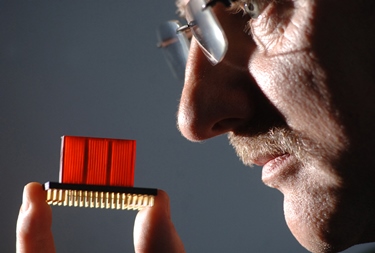Electronic noses
Electronic noses for food, health and other applications
 The first commercial electronic nose (aka e-nose) instruments were designed, developed and built by researchers in Warwick's School of Engineering in the 1990s. Warwick's patents in chemical sensing also led in 2008 to the creation of a spin-out company, Cambridge CMOS Sensors Ltd (CCS), which provides low-cost low-power gas-sensing technology and is already established in the gas-sensing market.
The first commercial electronic nose (aka e-nose) instruments were designed, developed and built by researchers in Warwick's School of Engineering in the 1990s. Warwick's patents in chemical sensing also led in 2008 to the creation of a spin-out company, Cambridge CMOS Sensors Ltd (CCS), which provides low-cost low-power gas-sensing technology and is already established in the gas-sensing market.
The smart sensors and instrumentation developed as a result of the pioneering research in artificial olfaction and chemical sensing have had economic impacts across a wide range of sectors, in particular in food quality, healthcare and consumer electronics. Thousands of e-nose instruments sold help quality assurance of foods, beverages and are now being deployed in hospitals for bacterial detection.
The measurement of smell is critical to industries worth billions of pounds, such as food processing, drinks, air quality, security (drugs) and cosmetics. Furthermore, malodour can be an indicator of bacterial infection and diseases so important for healthcare. Human (organoleptic) panels are routinely used to measure smell but are costly, slow and subjective hence the desire for an e-nose that can detect smell. To classify odours, the human olfactory system uses hundreds of different olfactory receptors and a specialized neural architecture. The functionality of such a complex system can be mimicked by an artificial system that uses electronic sensor arrays and pattern recognition algorithms. Building on the concept of an artificial nose - first proposed by the biochemists Dr George Dodd (Warwick until 1990) and Dr Krishna Persaud (Warwick until 1983) - Professor Julian Gardner (founder in 1987 of the Sensors Research Laboratory in Warwick's School of Engineering) and then PhD student Tim Pearce (graduated 1994) designed, developed and built the first commercial e-nose instruments in 1993.
Warwick's first electronic nose comprised an array of non-selective resistive metal oxide (MOX) gas sensors coupled to signal pre-processing algorithms, with its output fed into a pattern recognition system based upon neuralinspired algorithms. Early Warwick work included the use of metal oxide gas sensors and novel pre-processing and artificial neural networking algorithms to solve complex multi-variate problems. The replacement of an organoleptic panel was very attractive to save cost and quantify different types of odours. In 1998, Gardner started work funded by an EPRSC grant on silicon-based gas sensors. The project developed and proved the concept of low-power, silicon-on-insulator technology for metal oxide semiconductor field effect transistor (MOSFET) micro-hotplate heaters in gas detection that led to the first of several patents filed worldwide by Warwick. This is the first proposed use of a transistor embedded in a thin silicon membrane to make a micro heater, i.e. an ultra low-power and low cost heater that can be integrated with standard complementary metal oxide semiconductor (CMOS) circuitry.
Gardner and Florin Udrea (former Warwick masters student (1999-2002) who moved to Cambridge in 2003) started a research collaboration funded by the EPSRC in 2008. Warwick specifically led the UK's silicon-based gas-sensor developments, as exemplified by a patented tungsten-based micro-hotplate designed using high-temperature CMOS) electronics in 2006, which led to a 'smart-drive'-integrated on-chip control of a micro heater and hence silicon based gas sensor in 2008.
Gardner and Udrea realised that silicon-based gas sensors had significant market potential in consumer electronics because cheap, low-power sensor devices (<$5) with high output-signal stability could now be made. The silicon-based gas sensors were thus designed to have low power consumption and accurate temperature control, and also a one-order-of-magnitude higher sensitivity to hydrogen, ammonia, ozone, carbon dioxide and nitrogen dioxide gases and to volatile hydrocarbons such as benzene than the metal-oxide gas sensors. These sensors overcame previous technical challenges that prevented existing MOX gas sensors from being used in portable, battery-powered instruments to measure hazardous toxic gases and in low-power automotive units for polluting combustion gases. The scope of the invention was covered by patents filed by Warwick.
Gardner (currently head of Warwick's Microsensors & Bioelectronics Laboratory, formerly known as the Sensors Research Laboratory) continues to push forward the research and development of electronic noses, in particular the optimization of instrumentation for a range of commercial applications, such as breath analysis for low-cost healthcare monitoring.
Publications
Pearce, T. C. and Gardner, J. W. "Machine olfaction: intelligent sensing of odours", Proc. of IEEE conference on Systems, Man and Cybernetics (Le Touquet, France, 17-20 October 1993) 5, 165-170 Vol. 5, pp.165-170. (1993). DOI: 10.1109/ICSMC.1993.390843.
Hines, E. L. and Gardner, J. W. "An artificial neural emulator for an odour sensor array", Sensors and Actuators B 19, 661-664 (1994). DOI: 10.1016/0925-4005(93)01117-M.
Gardner, J. W., Pearce, T. C., Friel, S., Bartlett, P. N. and Blair, N "A multisensor system for beer flavour monitoring using an array of conducting polymers and predictive classifiers", Sensors and Actuators B 18,(1-3) 240-243 (1994). DOI: 10.1016/0925-4005(94)87089-6.
Ali, S. Z., Udrea, F., Milne, W. I. and Gardner J. W. "Tungsten-based SOI microhotplates for smart gas sensors", J. Microelectromechanical Systems 17(6), 1408-1417 (2008). DOI: 10.1109/JMEMS.2008.2007228.
